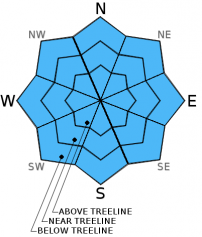| Monday | Monday Night | Tuesday | |
|---|---|---|---|
| Weather: | Partly cloudy becoming mostly cloudy with a slight chance of isolated showers | Mostly cloudy with a slight chance of isolated showers | Mostly cloudy |
| Temperatures: | 44 to 51 deg. F. | 33 to 37 deg. F. | 45 to 52 deg. F. |
| Mid Slope Winds: | Southwest | West | Southwest |
| Wind Speed: | 10 to 20 mph with gusts to 30 mph | 10 to 20 mph with gusts to 35 mph | 15 to 25 mph with gusts to 40 mph |
| Expected snowfall: | 0 | 0 | 0 |
| Monday | Monday Night | Tuesday | |
|---|---|---|---|
| Weather: | Partly cloudy becoming mostly cloudy with a slight chance of isolated showers | Mostly cloudy with a slight chance of isolated showers | Mostly cloudy |
| Temperatures: | 38 to 44 deg. F. | 28 to 34 deg. F. | 38 to 44 deg. F. |
| Ridge Top Winds: | Southwest | West shifting to the southwest | Southwest |
| Wind Speed: | 20 to 30 mph with gusts to 45 mph | 15 to 25 mph with gusts to 35 mph increasing to 20 to 35 mph with gusts to 55 mph after midnight | 25 to 40 mph with gusts to 60 mph |
| Expected snowfall: | 0 | 0 | 0 |
























